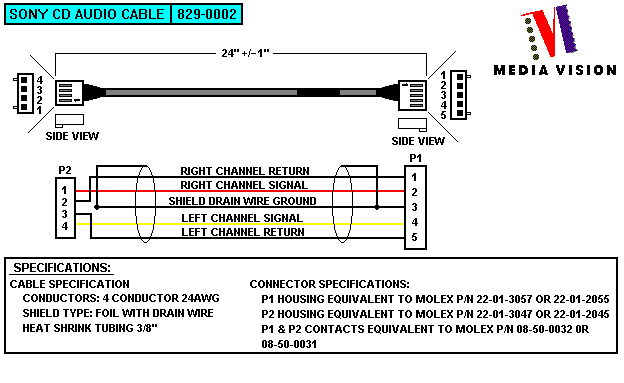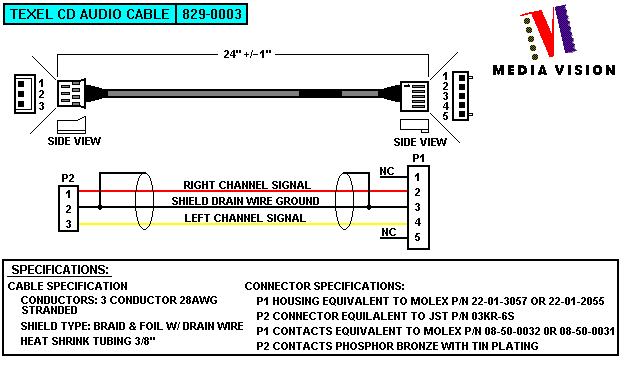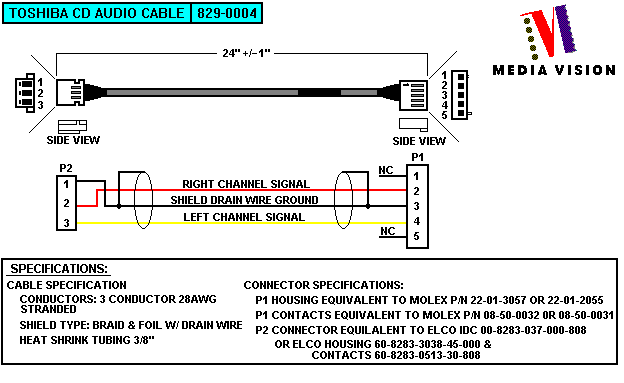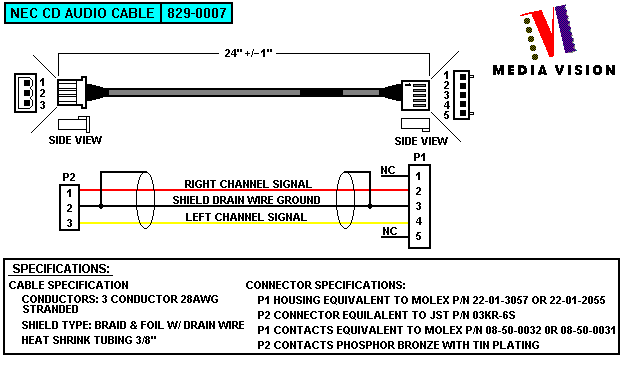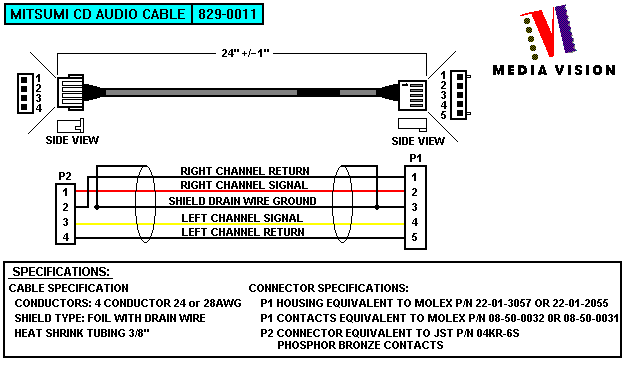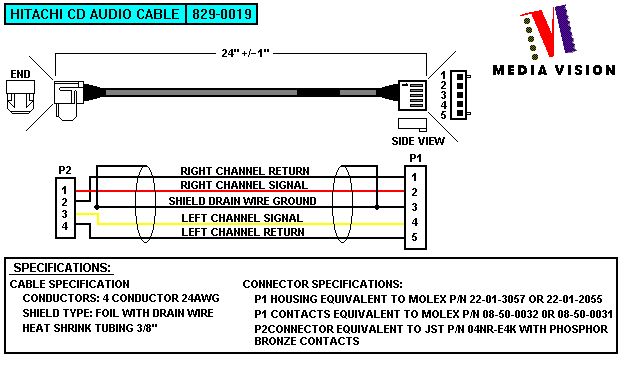Difference between revisions of "CD audio connectors"
Malvineous (Talk | contribs) (Document some different cable types) |
Malvineous (Talk | contribs) (Add intro and JST PH series for SBCD connector) |
||
| (One intermediate revision by the same user not shown) | |||
| Line 1: | Line 1: | ||
| + | The '''CD audio connector''' is used to transfer an analogue audio signal from a CD drive to a sound card, where it is mixed with the card's normal audio output. | ||
| + | |||
| + | It also sees other use, such as MPEG decoder cards which often supply both an input and output connector, allowing CD audio to be passed through the MPEG decoder and on to the sound card, where the sound card's CD input will receive combined audio from both the MPEG decoder card and the CD drive. | ||
| + | |||
| + | Later dial-up modems supporting voice calls often used a CD audio connector but with a different pin assignment, creating the [[TAD]] connector. This is used to supply microphone signals to the modem and to receive audio of the phone call for playing through the sound card's output. | ||
| + | |||
| + | == MPC-2 == | ||
| + | |||
| + | The '''MPC-2''' connector is the most recent standard, used by most drives since the late 1990s. It uses a [http://www.molex.com/molex/products/datasheet.jsp?part=active/0701070002_CRIMP_HOUSINGS.xml Molex 70107] connector, which has standard 2.54mm spacing so it can mate with the older 4-pin Dupont connectors. In addition it has a locking clip to prevent the connector from working its way loose. | ||
| + | |||
| + | The pinout is R-G-G-L, with R being pin 1. | ||
| + | |||
| + | == 4-pin Dupont == | ||
| + | |||
| + | This is a standard type of PCB connector, having been used to connect the PC speaker since the very first PCs. It is physically compatible with the later '''MPC''' standard, however the signal lines are not standardised. Many were R-G-G-L so are compatible with MPC, but there are likely to be other versions that use R-G-L-G which was another common layout. | ||
| + | |||
| + | For this reason when specifying a 4-pin Dupont connector, it should be listed as '''4-pin Dupont RGGL''' to avoid ambiguity. | ||
| + | |||
| + | == SoundBlaster CD audio == | ||
| + | |||
| + | This tiny connector is a JST PH 2.0 four circuit connector (JST brand, PH series, 2.0mm pitch, 4-pin.) It is used on Creative Labs sound cards as the earliest CD audio connector, and saw later use on other cards as well, e.g. MPEG decoders. | ||
| + | |||
| + | The pinout for this connector is O-L-G-R, with R being pin 4. (O is Open, or "not connected".) | ||
| + | |||
| + | Apparently the connector changes on AWE64 cards, and becomes L-O-G-R, as if the MPC pin layout was used by accident. | ||
| + | |||
== Sony CD audio == | == Sony CD audio == | ||
[[Image:Sony CD audio cable.gif|right]] | [[Image:Sony CD audio cable.gif|right]] | ||
| Line 22: | Line 48: | ||
== Hitachi CD audio == | == Hitachi CD audio == | ||
[[Image:Hitachi CD audio cable.gif|right]] | [[Image:Hitachi CD audio cable.gif|right]] | ||
| + | |||
| + | == External links == | ||
| + | |||
| + | * [http://www.aesystems.com/cdrom_audio_connectors.html AE Systems CD audio cable technote] | ||
[[Category:CD audio]] | [[Category:CD audio]] | ||
Latest revision as of 15:18, 21 February 2017
The CD audio connector is used to transfer an analogue audio signal from a CD drive to a sound card, where it is mixed with the card's normal audio output.
It also sees other use, such as MPEG decoder cards which often supply both an input and output connector, allowing CD audio to be passed through the MPEG decoder and on to the sound card, where the sound card's CD input will receive combined audio from both the MPEG decoder card and the CD drive.
Later dial-up modems supporting voice calls often used a CD audio connector but with a different pin assignment, creating the TAD connector. This is used to supply microphone signals to the modem and to receive audio of the phone call for playing through the sound card's output.
Contents
MPC-2
The MPC-2 connector is the most recent standard, used by most drives since the late 1990s. It uses a Molex 70107 connector, which has standard 2.54mm spacing so it can mate with the older 4-pin Dupont connectors. In addition it has a locking clip to prevent the connector from working its way loose.
The pinout is R-G-G-L, with R being pin 1.
4-pin Dupont
This is a standard type of PCB connector, having been used to connect the PC speaker since the very first PCs. It is physically compatible with the later MPC standard, however the signal lines are not standardised. Many were R-G-G-L so are compatible with MPC, but there are likely to be other versions that use R-G-L-G which was another common layout.
For this reason when specifying a 4-pin Dupont connector, it should be listed as 4-pin Dupont RGGL to avoid ambiguity.
SoundBlaster CD audio
This tiny connector is a JST PH 2.0 four circuit connector (JST brand, PH series, 2.0mm pitch, 4-pin.) It is used on Creative Labs sound cards as the earliest CD audio connector, and saw later use on other cards as well, e.g. MPEG decoders.
The pinout for this connector is O-L-G-R, with R being pin 4. (O is Open, or "not connected".)
Apparently the connector changes on AWE64 cards, and becomes L-O-G-R, as if the MPC pin layout was used by accident.
Sony CD audio
The Sony cable looks very similar to a floppy power (Berg) connector, but it has different keying pins.
Texel CD audio
Toshiba CD audio
NEC CD audio
Mitsumi CD audio
